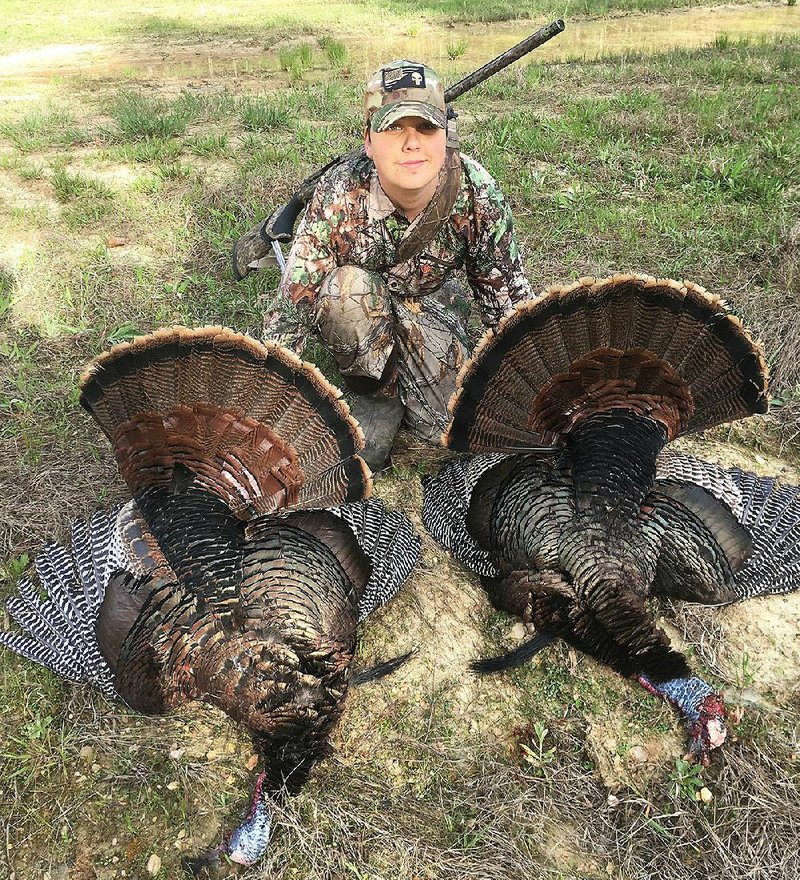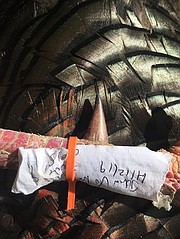Bonded by blood and a love of hunting, the Volpe family passed its sporting heritage forward and back during the spring turkey season.
Federal magistrate judge Joe Volpe of Little Rock began hunting turkeys with his son John Volpe, 15, in 2016. That's when John bagged his first turkey, a mature Rio Grande gobbler, in Kansas. In March, he killed his fifth Rio in Texas.
Until April 9, Joe Volpe had taken five gobblers and a bearded hen, all in Kansas. The bearded hen exemplified what Joe Volpe calls the "Volpe Curse."
"The bearded hen is a Volpe family controversy," Joe Volpe said. "That's where John's gun would not fire after I cleaned it, so I took the hen. Whether or not I sabotaged his gun, I will take to my grave."
The curse struck again in Texas, when a mature gobbler advanced on the Volpes' turkey decoy. A herd of Watusi cattle surrounding the decoy and prevented the gobbler from approaching.
"That decoy just spun around and around while those cows licked it," Joe Volpe said.
Killing any mature gobbler is a feat, but killing a mature eastern gobbler is the gold standard for turkey hunting. It is the wiliest and wariest of the five North American sub-species, but Arkansas easterns are believed to be warier than most.
For that reason, said Steve Bowman, former outdoor editor of the Arkansas Democrat-Gazette and a member of the Arkansas Outdoor Hall of Fame, turkey hunters in other states are in awe of successful Arkansas turkey hunters.
The Volpes dedicated themselves to the Arkansas spring turkey season, which began April 6 on a Grant County gas pipeline during the special youth season. The Volpe Curse almost ended that hunt before it began.
"A vehicle came real slowly down the road," Joe Volpe said. "I think they were poaching. Their lights hit that decoy in the middle of the road and they stopped and slowly backed out. Thank goodness they did."
A gobbler showed up, but it responded only when Joe Volpe called simultaneously with his mouth call and box call. The bird was loud and close, but then it went silent.
"I'm all pie-eyed, and John can't see it, either," Joe Volpe said. "All of a sudden I see that bird pop in. John cant see it because it's too far to his left, but it was strutting and putting on a show for the decoy.
John finally saw the bird when it crossed to the right, but it smelled a rat and had become tentative at about 40 yards.
"I said, 'John, you've got to shoot that bird,' " Joe Volpe said. "He said, 'It's too far!'
"Finally John couldn't resist. He made a great shot and laid it down."
On April 8, opening day of the spring turkey season, Joe Volpe participated in a controlled turkey hunt at the Camp Robinson Wildlife Management Area. Hunting in the afternoon, he saw a group of hens in a road about 200 yards away. Through binoculars, he determined that two were mature gobblers. At about 3:30 p.m., the gobblers advanced on his calls but hung up about 100 yards away in a grassy area in the woods.
Instead of pressing the issue, Volpe noted their location at that time and resolved to return to the same spot at the same time on April 9.
After setting up the next day, Volpe realized he was sitting in the path that the birds would probably take to the strutting zone. He moved to a knoll that gave him a downward shot and placed a decoy in the strutting area.
Right on time, the gobblers showed up at about 3 p.m.
"They hammered like thunder," Volpe said. "I was hyperventilating and freaking out. They were spitting and drumming behind me, coming down the path like I thought they would."
With one bird in range, Volpe darted his eyes to the side to look for the second bird. The first bird caught the movement and scurried a short distance before stopping to look back.
"He stuck his head up, and I busted him," Volpe said.
That bird weighed 211/2 pounds and had a 101/2-inch beard. Its spurs were 1 inch long.
On Friday, the Volpes returned to Grant County. John wanted to call in a bird for his father with a Bill Rhodes box call that a friend gave him the night before.
With multiple birds gobbling, Joe Volpe handed his shotgun to his son, but John demurred.
"No, I'm guiding you," John said.
"What if two come in at the same time?" Joe asked.
"That'll never happen," John replied.
Call it half of the Volpe Curse. Two gobblers came indeed, and they were highly offended at the jake decoy accompanying the hen decoy.
"They were winding back and forth the way turkeys do," Joe Volpe said. "They both had huge beards, and John's saying, 'The big one's on the left! No, he's on the right! Wait, he's on the left!"
When the first bird got in range, Joe made an easy shot on a 22-pound gobbler that had a 101/2-inch beard.
With so many gobblers in the area, the Volpes decided to try for a double.
About 45 minutes later, they agreed that they needed to move. As Joe rose to retrieve the decoys, he saw turkeys about 400 yards down the pipeline. They didn't respond to calling, so the Volpes decided to try luring in a gobbler with a fake turkey fan.
John sat in an ideal ambush position while Joe belly-crawled to an open area where the gobbler could see the fan.
"John was laughing at this old man huffing and puffing and trying to slow crawl to this open area," Joe Volpe said.
When the gobbler spied the fan, it peeled away from the flock and meandered slowly toward the ambush.
"At some point he got mad," Joe Volpe said. "His head turned bright red, and he started trotting to us. Of course, John is a prankster, and my next thought was, 'You'd better not let that bird come up here and kick my a**!' "
Not to worry. John shot the bird at 15 yards.
Father and son tagged out the same day on Arkansas eastern gobblers, which might be the hardest feat of all.
Better yet, the Volpe Curse seems to have been vanquished.
Sports on 04/21/2019


